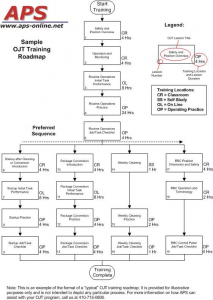Structured On-the-Job-Training (OJT) Programs
APS specializes in the design and development of effective customized structured OJT programs for all industries.

APS training specialists can assist your organization in all phases of creating an effective structured OJT (SOJT) training program. Our OJT program development services including job task analysis (JTA) and design of an OJT roadmap, OJT lesson guides, job performance measures (JPMs), and the supporting job training manuals and reference materials.
Our flexible approach allows clients to collaborate with APS to develop the program or outsource the entire effort to APS. For best results, APS recommends a collaborative approach to foster ownership by your organization.
Why is OJT more important in 2024 than ever before?
In today’s business climate, our clients are telling us that it’s nearly impossible to hire people who possess all the skills and knowledge that we wish they had. The only reasonable alternative is to hire people with the fundamental (raw) abilities to do the job and provide effective structured OJT training programs to give them the specific knowledge and skills that they need.
In addition, as the sophistication of automated processes has increased, we are continually asking our people to take on increased responsibilities. Without an effective structured training program, we are setting ourselves up for failure.
What is an OJT Program?
OJT programs can take several forms. For some trainers, “on-the-job-training” means a total lack of a formal training program. Traditional unstructured OJT often consists of a trial-by-fire method of job training where people are forced to learn a job on their own, receiving guidance only when they make a mistake.
For others, OJT is a training method where experienced employees take new employees under their wing, instructing and coaching them on how to perform their job, giving them the benefit of years of experience.
Traditional unstructured OJT training methods have some advantages and disadvantages as described below:
Advantages of Traditional Unstructured OJT:
Low cost – does not require the development of potentially expensive training materials or classroom/computer-based instruction.
Task-based – Since OJT is performed at the work area, training tends to be focused on performing real job tasks.
Well suited for small groups – OJT is often the most practical training method when you only need to train one or two employees at a time.
Disadvantages of Traditional Unstructured OJT :
Inconsistent – Traditional OJT relies heavily on an experienced employee to provide the instruction based on what they feel are the most important topics. What is important to one employee may not be important to another. The result is what is learned may vary greatly, depending on who is assigned as the trainer.
Incomplete – Without a structured lesson guide, OJT trainers often forget to cover important information. What is learned is likely to be based on what happened that day rather than on what a new employee needs to know to be safe and productive.
Lack of founding principles – While the hands-on aspect of OJT may appeal to the practical learner, often the underlying theories of operation are not covered in sufficient detail or accuracy. Without this foundation of knowledge, trainees often learn what to do, not why they are doing it, resulting in poor decision making when things don’t go exactly right.
Bad habits – The trainee observes and may adopt the trainer’s habits and attitudes about all aspects of the job including safety, quality, customer service, and relationship with management. Poorly selected trainers can have many unintended consequences.
What is a Structured OJT Program and Why is it Better?
APS recommends using a structured approach to OJT to overcome disadvantages of traditional OJT programs while maintaining the advantages. A good Structured OJT (SOJT) Program consists of four main components:
Roadmap
Lesson Guides
Job Performance Measures (JPM)
Supporting Documentation
SOJT Roadmap
The SOJT roadmap is a detailed flowchart that breaks down the training process into defined units or modules that will need to be completed for a specific job or position. Breaking the SOJT process down into bite-sized pieces allows the training to be accomplished over a period of time within a practical timeframe.
Each module on the roadmap represents a lesson with defined objectives along with the delivery mode and the estimated duration. The roadmap also shows a path of progression or a logical order for completing the individual lessons. Click on the flow chart icon to view a typical SOJT Training Roadmap.
Sample SOJT Training Roadmap
SOJT Lesson Guides
A lesson guide is provided for each module in the SOJT roadmap. The SOJT lesson guide outlines the objectives to be completed and contains a step-by-step listing or checklist of the activities to be performed during that lesson and the optimum order of completion. Using a defined checklist ensures all of the pertinent topics are covered instead of relying on the memory of the instructor. It also allows the trainee to be an active participant in the training by asking questions when everything is not getting covered.
Typical OJT lesson activities include:
Trainer and trainee review the supporting document(s)
Trainer explains the theory of operation to the trainee
Trainer demonstrates proper performance of a task
Trainee performs the task with assistance from the trainer
Trainee performs the task while the trainer observes and coaches
This process is ideal for tasks that can be performed repeatedly. However, for infrequently performed or emergency tasks that seldom occur, the process must be modified. In addition, the lesson guide provides a listing of supporting documentation for the lesson. These supporting documents will serve a reference for the lesson, providing information that supplements and amplifies the knowledge of the SOJT instructor.
Job Performance Measures (JPM)
Testing for the acquisition of job task skills and knowledge is accomplished using Job Performance Measures (JPM). A JPM is the practical “test” portion of the SOJT lesson and provides a checklist of the tasks that must be performed and the standards to which they must be performed.
During performance of the JPM, the trainee performs the designated tasks under the observation of but without the assistance of the trainer. Upon successful completion of the JPM, both trainer and trainee document the performance of each task. The completed JPM document may serve as an official record of training.
Supporting Documentation
The lesson guide lists supporting documentation required for the lesson. A key part of the SOJT development process involves identifying which documents should be used to support the SOJT lesson. Where possible, existing documents should be used, and may consist of:
Existing work instructions
Safety instructions
Checklists and job aids
Piping and Instrumentation Diagrams (P&IDs)
Federal, state, or local regulations and manuals
Equipment vendor (OEM) technical manuals
In some cases, new supporting documents may need to be developed that will provide the baseline information needed to conduct effective OJT.
Structured OJT Instructors
The roadmap, SOJT lesson guides and supporting documentation provide the structure, but the overall effectiveness of an SOJT program still relies on the SOJT instructors to provide the transfer of knowledge.
To ensure maximum effectiveness of your SOJT program, trainers should be selected based on their knowledge of the job and their willingness to share that knowledge with others. The employer should also consider the employee’s attitudes about key company policies such as safety, quality, and customer service.
All persons who are designated as OJT trainers should receive instruction in the proper use of the SOJT documents, how to deliver effective SOJT lessons, and the principles of adult learning.
APS can help you develop on-the-job training documents and train your employees to be effective SOJT instructors. For more information, please email us at info@aps-online.net or call us at 610-987-4050.
